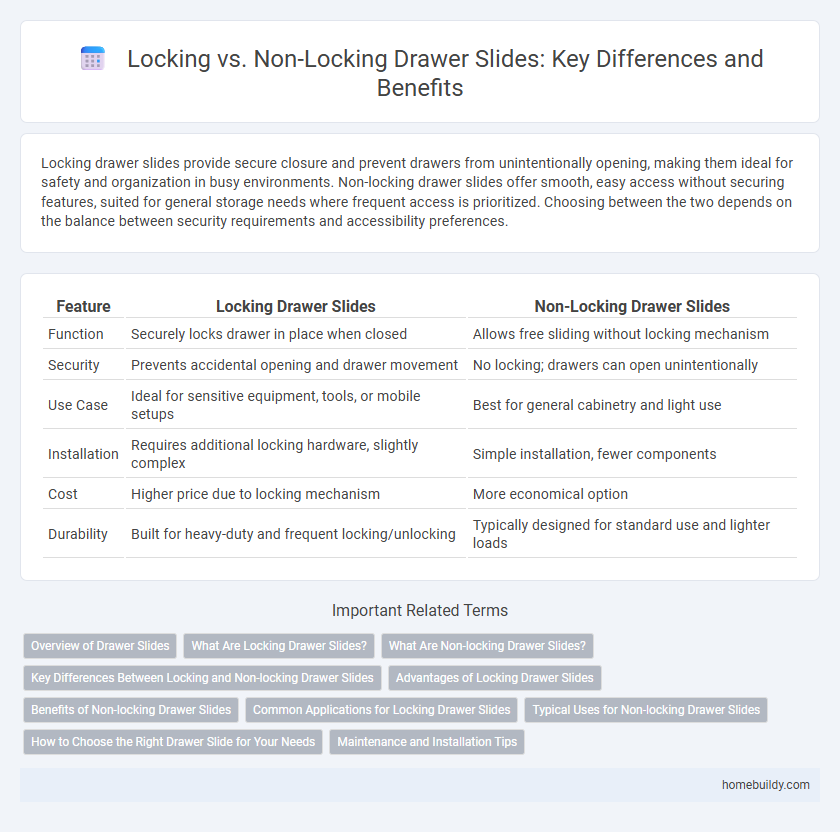Locking drawer slides provide secure closure and prevent drawers from unintentionally opening, making them ideal for safety and organization in busy environments. Non-locking drawer slides offer smooth, easy access without securing features, suited for general storage needs where frequent access is prioritized. Choosing between the two depends on the balance between security requirements and accessibility preferences.
Table of Comparison
| Feature | Locking Drawer Slides | Non-Locking Drawer Slides |
|---|---|---|
| Function | Securely locks drawer in place when closed | Allows free sliding without locking mechanism |
| Security | Prevents accidental opening and drawer movement | No locking; drawers can open unintentionally |
| Use Case | Ideal for sensitive equipment, tools, or mobile setups | Best for general cabinetry and light use |
| Installation | Requires additional locking hardware, slightly complex | Simple installation, fewer components |
| Cost | Higher price due to locking mechanism | More economical option |
| Durability | Built for heavy-duty and frequent locking/unlocking | Typically designed for standard use and lighter loads |
Overview of Drawer Slides
Locking drawer slides feature mechanisms that secure the drawer in a closed or fully extended position, preventing accidental movement and enhancing safety in environments like tool cabinets and medical carts. Non-locking drawer slides provide smooth, uninterrupted sliding action without securing the drawer, ideal for applications requiring frequent access and easy operation. Both options vary in load capacities, materials, and extension lengths to suit specific industrial, commercial, or residential needs.
What Are Locking Drawer Slides?
Locking drawer slides provide enhanced security by incorporating a mechanism that locks the drawer in place when fully extended or closed, preventing accidental opening or movement. These slides are ideal for applications requiring stability and safety, such as in tool chests, medical cabinets, or industrial storage units. Non-locking drawer slides lack this locking feature, allowing free sliding motion without secure positioning.
What Are Non-locking Drawer Slides?
Non-locking drawer slides are hardware components that allow drawers to open and close smoothly without any mechanism to lock them in place. They provide easy access and movement, ideal for applications where drawer security or stability when extended is not a priority. Commonly used in residential furniture and light-duty cabinetry, non-locking slides offer a cost-effective and straightforward solution for drawer functionality.
Key Differences Between Locking and Non-locking Drawer Slides
Locking drawer slides feature a mechanism that secures the drawer in place, preventing accidental opening and offering enhanced safety and stability, especially in mobile environments or heavy-duty applications. Non-locking drawer slides lack this locking function, allowing for smoother, unrestricted opening and closing, ideal for easy access in standard furniture settings. The key difference lies in the locking capability, which affects both the drawer's security and suitability for specific uses, with locking slides preferred for secure storage and non-locking slides favored for convenience.
Advantages of Locking Drawer Slides
Locking drawer slides provide enhanced security by preventing drawers from unintentionally opening during movement or vibrations, making them ideal for mobile environments and heavy-duty applications. They ensure contents remain securely stored, reducing the risk of spills, damage, or loss in settings like workshops, vehicles, and industrial equipment. Locking mechanisms also improve user safety by stabilizing the drawer when extended, supporting heavier loads without accidental closures.
Benefits of Non-locking Drawer Slides
Non-locking drawer slides offer smooth and effortless operation, enhancing ease of access in frequently used storage spaces. Their simpler design reduces maintenance needs and lowers the risk of mechanical failure, ensuring long-term reliability. These slides provide a cost-effective solution for applications where quick drawer removal or free movement is prioritized over securing contents.
Common Applications for Locking Drawer Slides
Locking drawer slides are commonly used in medical cabinets, tool chests, and industrial storage units where secure access and safety are critical. These slides prevent accidental drawer opening during transport or vibrations, making them ideal for mobile equipment and emergency response vehicles. Their locking mechanism ensures contents remain intact and accessible only when needed, enhancing both security and functionality in professional environments.
Typical Uses for Non-locking Drawer Slides
Non-locking drawer slides are commonly used in furniture, kitchen cabinetry, and office desks where frequent access and smooth operation are essential without the need for securing the drawer in place. These slides facilitate easy opening and closing, making them ideal for storing everyday items like utensils, stationery, and clothing. Their simplicity and cost-effectiveness suit residential and commercial applications where locking mechanisms are unnecessary.
How to Choose the Right Drawer Slide for Your Needs
Locking drawer slides provide secure closure, ideal for preventing accidental openings in mobile or high-traffic environments, while non-locking slides offer smoother, simpler operation for everyday use. Consider the drawer's purpose, weight capacity, and safety requirements when selecting between locking and non-locking slides to ensure optimal performance and durability. For heavy-duty applications or sensitive contents, locking slides enhance security, whereas non-locking slides suit lightweight, frequently accessed drawers.
Maintenance and Installation Tips
Locking drawer slides require regular checks to ensure the locking mechanism functions smoothly, preventing jams and ensuring secure closure, while non-locking slides need lubrication to maintain smooth movement and prevent wear. During installation, locking slides demand precise alignment to engage locks effectively, whereas non-locking slides offer easier installation with fewer alignment constraints. Proper maintenance of both types extends lifespan and reliability, with locking slides benefiting from periodic cleaning of locking components and non-locking slides from routine lubrication of sliding surfaces.
Locking drawer slides vs Non-locking drawer slides Infographic

 homebuildy.com
homebuildy.com